Organizational Change Management in Aged Care: An Analysis
VerifiedAdded on 2020/02/18
|13
|3149
|44
Report
AI Summary
This report provides a comprehensive analysis of change management within the Australian aged care sector. It begins by outlining the significant transformations occurring, driven by technological advancements and the need for improved human resource management. The report identifies problems, such as workforce detachment, skill gaps, technology adoption issues, and communication barriers, while also detailing the government's phased approach to reforms. It then utilizes Lewin's Change Model and Kotter's 8-step model to analyze effective change management strategies, focusing on workforce development, policy adaptation, and the importance of employee training and motivation. The report emphasizes the need for multi-skilled workers, continuous adaptation to policy changes, and the incorporation of learning to improve the quality of service provided to the aged population. Furthermore, the report discusses key elements of the change process, including vision, method, and will, as well as the importance of addressing performance gaps and fostering productivity gains, employee satisfaction, and quality improvements.
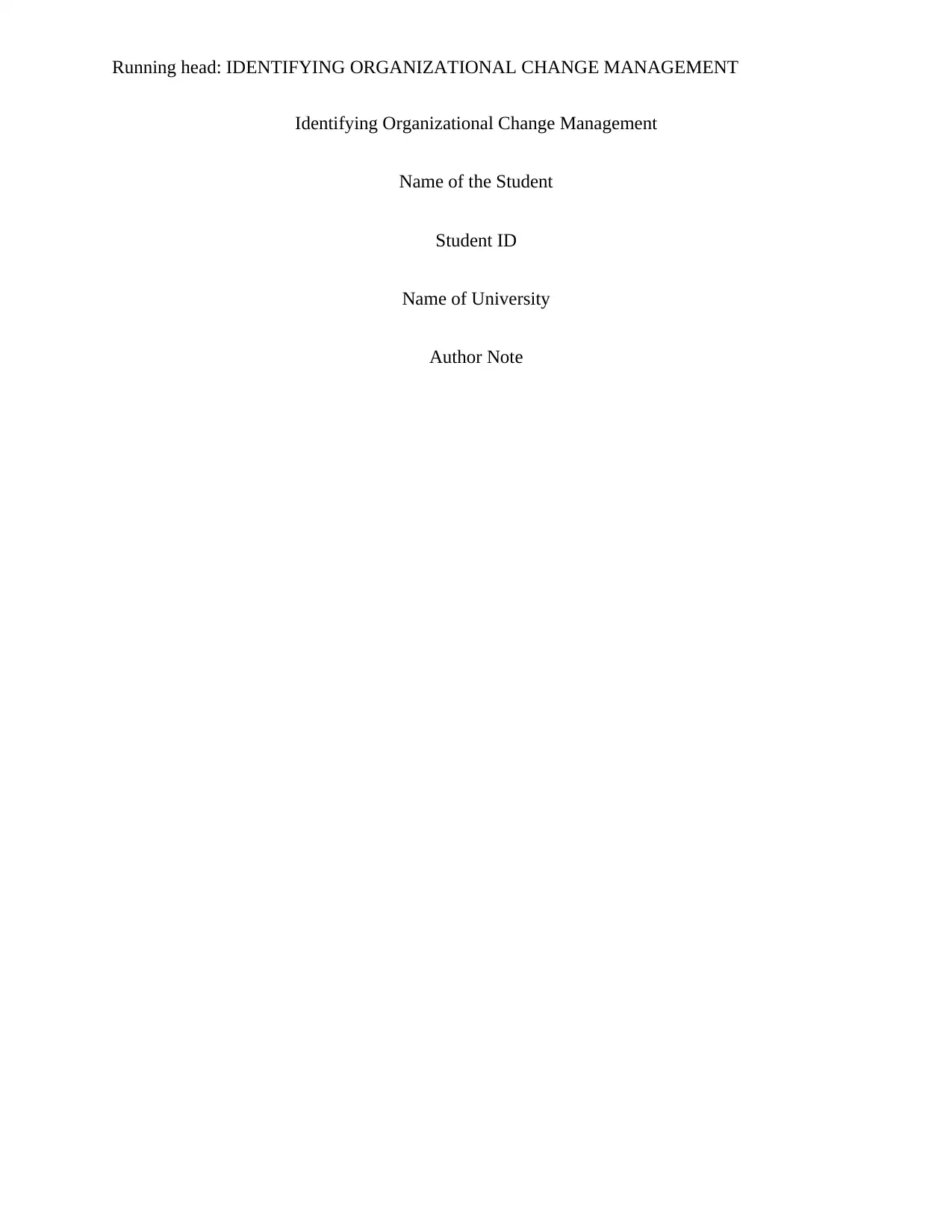
Running head: IDENTIFYING ORGANIZATIONAL CHANGE MANAGEMENT
Identifying Organizational Change Management
Name of the Student
Student ID
Name of University
Author Note
Identifying Organizational Change Management
Name of the Student
Student ID
Name of University
Author Note
Paraphrase This Document
Need a fresh take? Get an instant paraphrase of this document with our AI Paraphraser
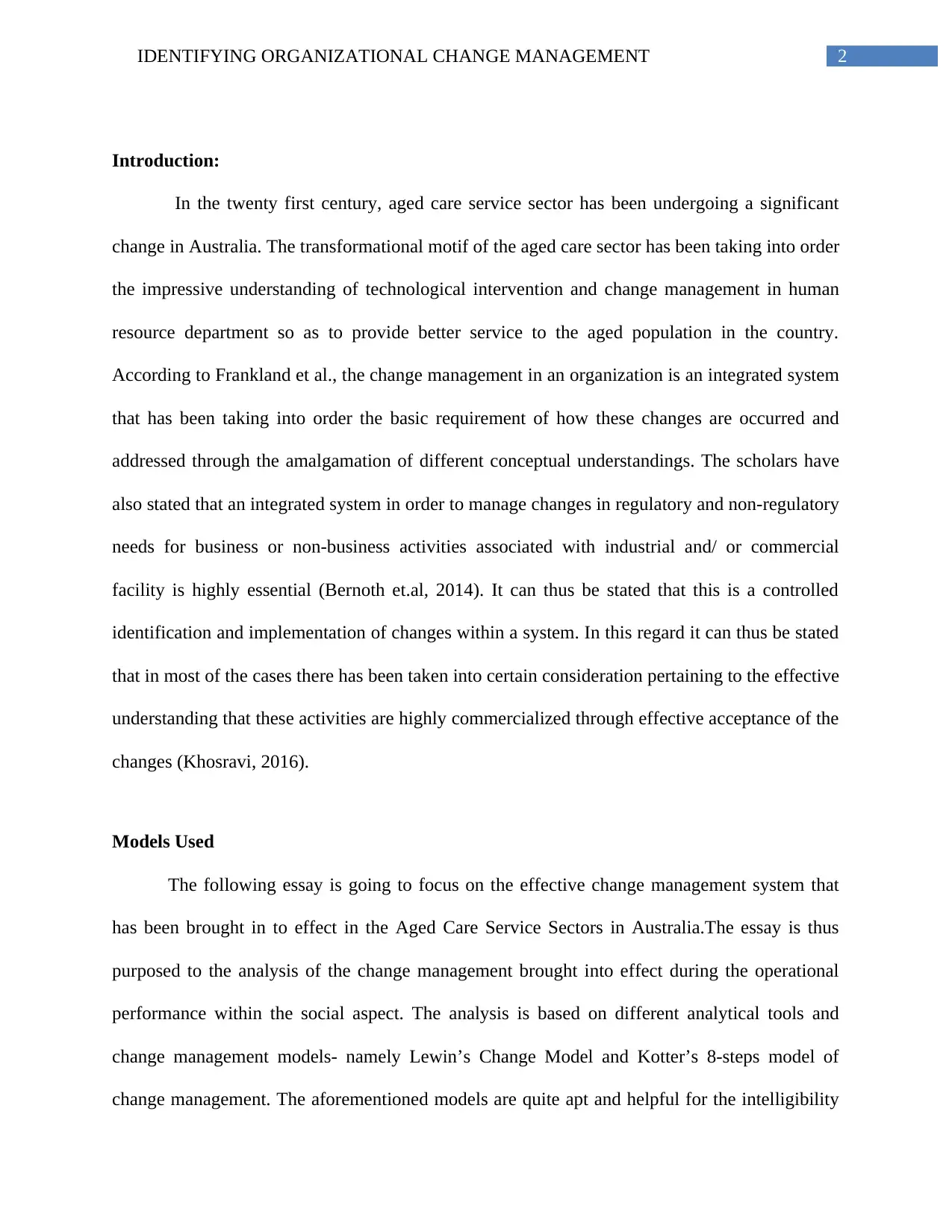
2IDENTIFYING ORGANIZATIONAL CHANGE MANAGEMENT
Introduction:
In the twenty first century, aged care service sector has been undergoing a significant
change in Australia. The transformational motif of the aged care sector has been taking into order
the impressive understanding of technological intervention and change management in human
resource department so as to provide better service to the aged population in the country.
According to Frankland et al., the change management in an organization is an integrated system
that has been taking into order the basic requirement of how these changes are occurred and
addressed through the amalgamation of different conceptual understandings. The scholars have
also stated that an integrated system in order to manage changes in regulatory and non-regulatory
needs for business or non-business activities associated with industrial and/ or commercial
facility is highly essential (Bernoth et.al, 2014). It can thus be stated that this is a controlled
identification and implementation of changes within a system. In this regard it can thus be stated
that in most of the cases there has been taken into certain consideration pertaining to the effective
understanding that these activities are highly commercialized through effective acceptance of the
changes (Khosravi, 2016).
Models Used
The following essay is going to focus on the effective change management system that
has been brought in to effect in the Aged Care Service Sectors in Australia.The essay is thus
purposed to the analysis of the change management brought into effect during the operational
performance within the social aspect. The analysis is based on different analytical tools and
change management models- namely Lewin’s Change Model and Kotter’s 8-steps model of
change management. The aforementioned models are quite apt and helpful for the intelligibility
Introduction:
In the twenty first century, aged care service sector has been undergoing a significant
change in Australia. The transformational motif of the aged care sector has been taking into order
the impressive understanding of technological intervention and change management in human
resource department so as to provide better service to the aged population in the country.
According to Frankland et al., the change management in an organization is an integrated system
that has been taking into order the basic requirement of how these changes are occurred and
addressed through the amalgamation of different conceptual understandings. The scholars have
also stated that an integrated system in order to manage changes in regulatory and non-regulatory
needs for business or non-business activities associated with industrial and/ or commercial
facility is highly essential (Bernoth et.al, 2014). It can thus be stated that this is a controlled
identification and implementation of changes within a system. In this regard it can thus be stated
that in most of the cases there has been taken into certain consideration pertaining to the effective
understanding that these activities are highly commercialized through effective acceptance of the
changes (Khosravi, 2016).
Models Used
The following essay is going to focus on the effective change management system that
has been brought in to effect in the Aged Care Service Sectors in Australia.The essay is thus
purposed to the analysis of the change management brought into effect during the operational
performance within the social aspect. The analysis is based on different analytical tools and
change management models- namely Lewin’s Change Model and Kotter’s 8-steps model of
change management. The aforementioned models are quite apt and helpful for the intelligibility
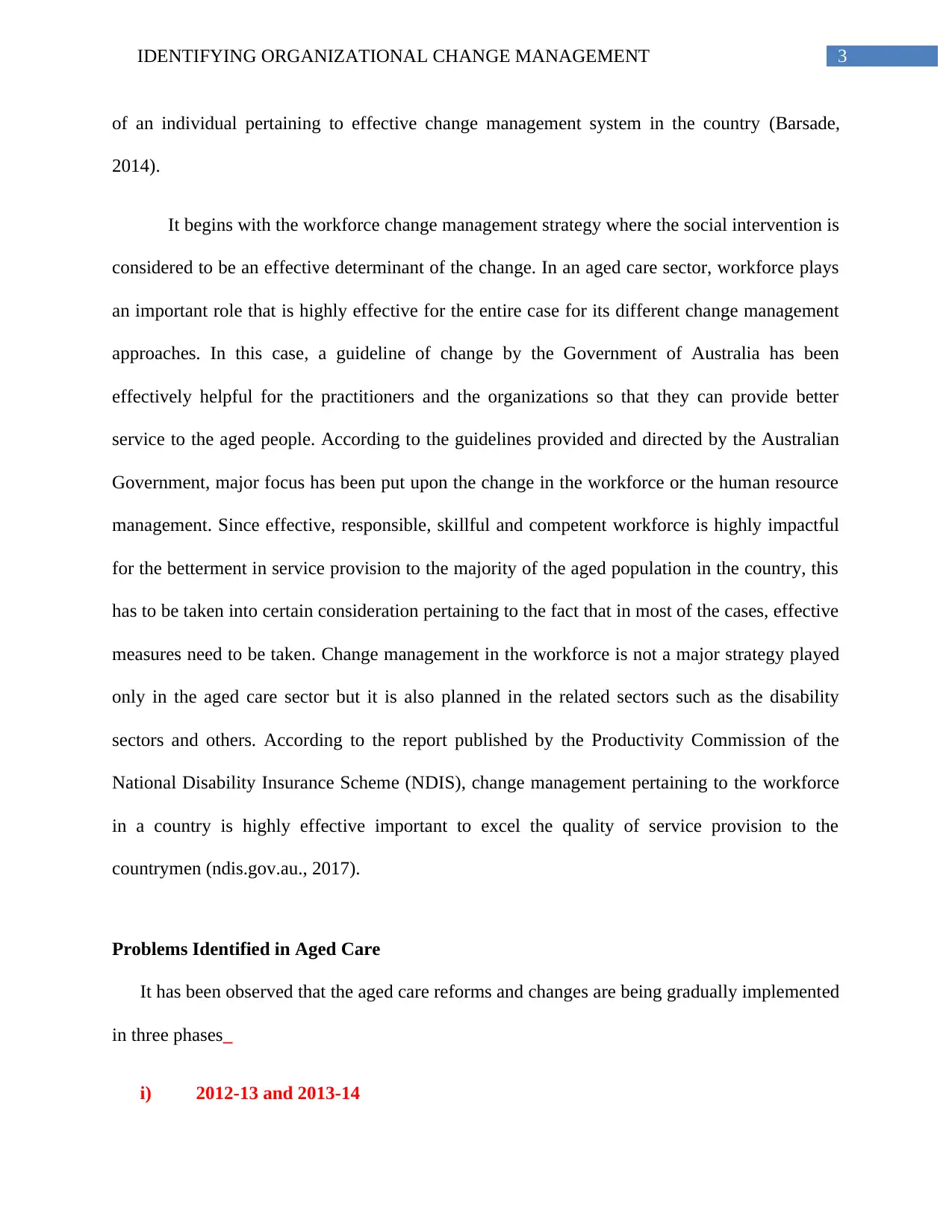
3IDENTIFYING ORGANIZATIONAL CHANGE MANAGEMENT
of an individual pertaining to effective change management system in the country (Barsade,
2014).
It begins with the workforce change management strategy where the social intervention is
considered to be an effective determinant of the change. In an aged care sector, workforce plays
an important role that is highly effective for the entire case for its different change management
approaches. In this case, a guideline of change by the Government of Australia has been
effectively helpful for the practitioners and the organizations so that they can provide better
service to the aged people. According to the guidelines provided and directed by the Australian
Government, major focus has been put upon the change in the workforce or the human resource
management. Since effective, responsible, skillful and competent workforce is highly impactful
for the betterment in service provision to the majority of the aged population in the country, this
has to be taken into certain consideration pertaining to the fact that in most of the cases, effective
measures need to be taken. Change management in the workforce is not a major strategy played
only in the aged care sector but it is also planned in the related sectors such as the disability
sectors and others. According to the report published by the Productivity Commission of the
National Disability Insurance Scheme (NDIS), change management pertaining to the workforce
in a country is highly effective important to excel the quality of service provision to the
countrymen (ndis.gov.au., 2017).
Problems Identified in Aged Care
It has been observed that the aged care reforms and changes are being gradually implemented
in three phases_
i) 2012-13 and 2013-14
of an individual pertaining to effective change management system in the country (Barsade,
2014).
It begins with the workforce change management strategy where the social intervention is
considered to be an effective determinant of the change. In an aged care sector, workforce plays
an important role that is highly effective for the entire case for its different change management
approaches. In this case, a guideline of change by the Government of Australia has been
effectively helpful for the practitioners and the organizations so that they can provide better
service to the aged people. According to the guidelines provided and directed by the Australian
Government, major focus has been put upon the change in the workforce or the human resource
management. Since effective, responsible, skillful and competent workforce is highly impactful
for the betterment in service provision to the majority of the aged population in the country, this
has to be taken into certain consideration pertaining to the fact that in most of the cases, effective
measures need to be taken. Change management in the workforce is not a major strategy played
only in the aged care sector but it is also planned in the related sectors such as the disability
sectors and others. According to the report published by the Productivity Commission of the
National Disability Insurance Scheme (NDIS), change management pertaining to the workforce
in a country is highly effective important to excel the quality of service provision to the
countrymen (ndis.gov.au., 2017).
Problems Identified in Aged Care
It has been observed that the aged care reforms and changes are being gradually implemented
in three phases_
i) 2012-13 and 2013-14
⊘ This is a preview!⊘
Do you want full access?
Subscribe today to unlock all pages.

Trusted by 1+ million students worldwide
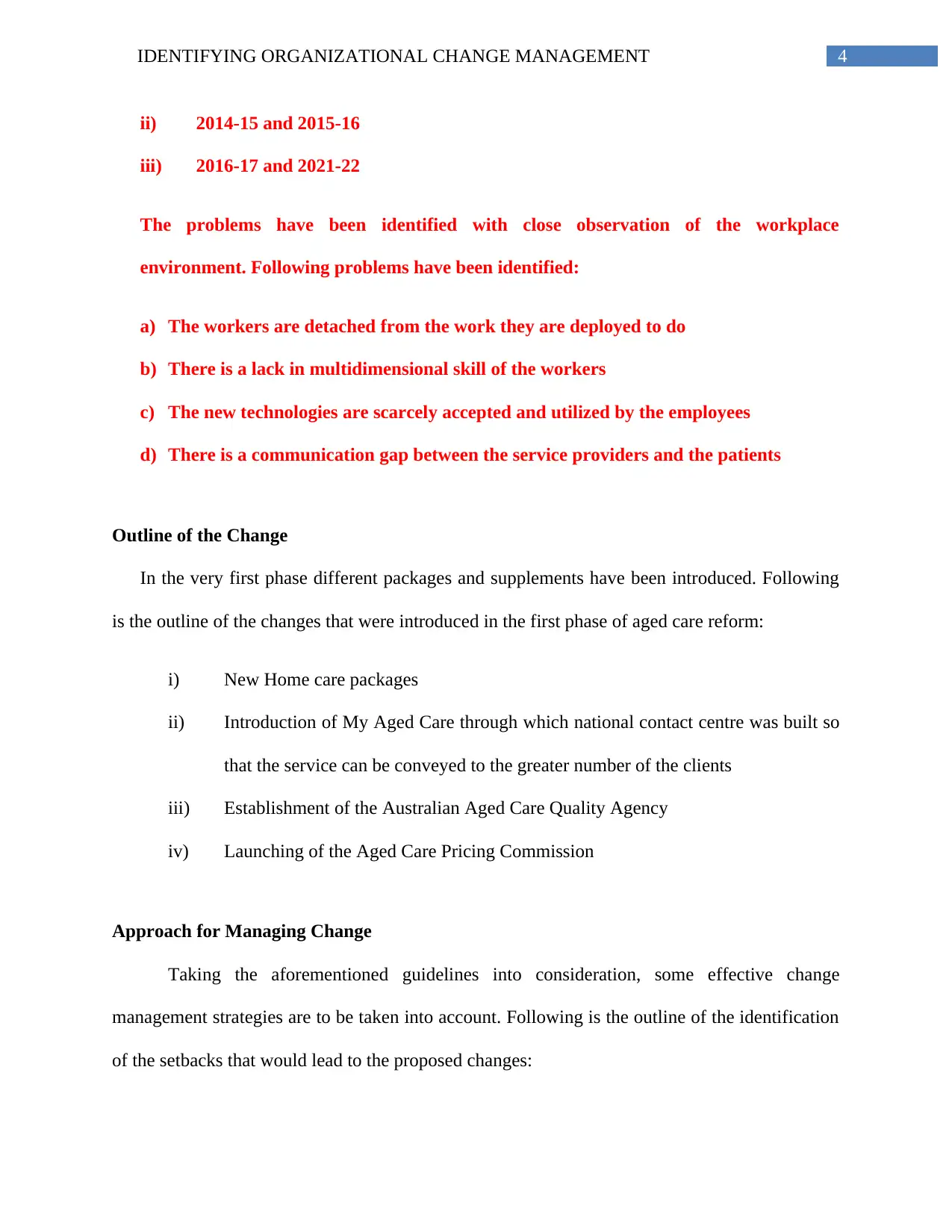
4IDENTIFYING ORGANIZATIONAL CHANGE MANAGEMENT
ii) 2014-15 and 2015-16
iii) 2016-17 and 2021-22
The problems have been identified with close observation of the workplace
environment. Following problems have been identified:
a) The workers are detached from the work they are deployed to do
b) There is a lack in multidimensional skill of the workers
c) The new technologies are scarcely accepted and utilized by the employees
d) There is a communication gap between the service providers and the patients
Outline of the Change
In the very first phase different packages and supplements have been introduced. Following
is the outline of the changes that were introduced in the first phase of aged care reform:
i) New Home care packages
ii) Introduction of My Aged Care through which national contact centre was built so
that the service can be conveyed to the greater number of the clients
iii) Establishment of the Australian Aged Care Quality Agency
iv) Launching of the Aged Care Pricing Commission
Approach for Managing Change
Taking the aforementioned guidelines into consideration, some effective change
management strategies are to be taken into account. Following is the outline of the identification
of the setbacks that would lead to the proposed changes:
ii) 2014-15 and 2015-16
iii) 2016-17 and 2021-22
The problems have been identified with close observation of the workplace
environment. Following problems have been identified:
a) The workers are detached from the work they are deployed to do
b) There is a lack in multidimensional skill of the workers
c) The new technologies are scarcely accepted and utilized by the employees
d) There is a communication gap between the service providers and the patients
Outline of the Change
In the very first phase different packages and supplements have been introduced. Following
is the outline of the changes that were introduced in the first phase of aged care reform:
i) New Home care packages
ii) Introduction of My Aged Care through which national contact centre was built so
that the service can be conveyed to the greater number of the clients
iii) Establishment of the Australian Aged Care Quality Agency
iv) Launching of the Aged Care Pricing Commission
Approach for Managing Change
Taking the aforementioned guidelines into consideration, some effective change
management strategies are to be taken into account. Following is the outline of the identification
of the setbacks that would lead to the proposed changes:
Paraphrase This Document
Need a fresh take? Get an instant paraphrase of this document with our AI Paraphraser
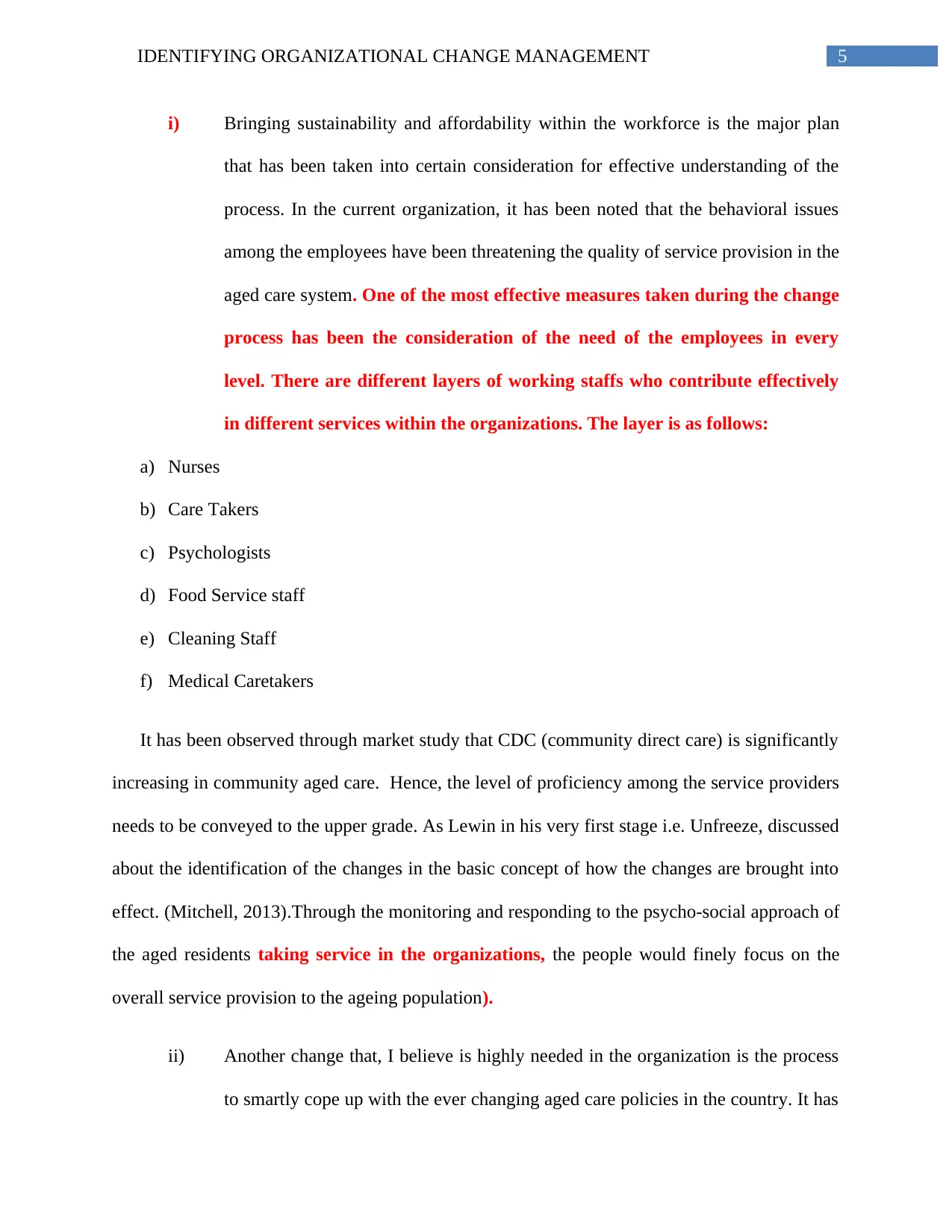
5IDENTIFYING ORGANIZATIONAL CHANGE MANAGEMENT
i) Bringing sustainability and affordability within the workforce is the major plan
that has been taken into certain consideration for effective understanding of the
process. In the current organization, it has been noted that the behavioral issues
among the employees have been threatening the quality of service provision in the
aged care system. One of the most effective measures taken during the change
process has been the consideration of the need of the employees in every
level. There are different layers of working staffs who contribute effectively
in different services within the organizations. The layer is as follows:
a) Nurses
b) Care Takers
c) Psychologists
d) Food Service staff
e) Cleaning Staff
f) Medical Caretakers
It has been observed through market study that CDC (community direct care) is significantly
increasing in community aged care. Hence, the level of proficiency among the service providers
needs to be conveyed to the upper grade. As Lewin in his very first stage i.e. Unfreeze, discussed
about the identification of the changes in the basic concept of how the changes are brought into
effect. (Mitchell, 2013).Through the monitoring and responding to the psycho-social approach of
the aged residents taking service in the organizations, the people would finely focus on the
overall service provision to the ageing population).
ii) Another change that, I believe is highly needed in the organization is the process
to smartly cope up with the ever changing aged care policies in the country. It has
i) Bringing sustainability and affordability within the workforce is the major plan
that has been taken into certain consideration for effective understanding of the
process. In the current organization, it has been noted that the behavioral issues
among the employees have been threatening the quality of service provision in the
aged care system. One of the most effective measures taken during the change
process has been the consideration of the need of the employees in every
level. There are different layers of working staffs who contribute effectively
in different services within the organizations. The layer is as follows:
a) Nurses
b) Care Takers
c) Psychologists
d) Food Service staff
e) Cleaning Staff
f) Medical Caretakers
It has been observed through market study that CDC (community direct care) is significantly
increasing in community aged care. Hence, the level of proficiency among the service providers
needs to be conveyed to the upper grade. As Lewin in his very first stage i.e. Unfreeze, discussed
about the identification of the changes in the basic concept of how the changes are brought into
effect. (Mitchell, 2013).Through the monitoring and responding to the psycho-social approach of
the aged residents taking service in the organizations, the people would finely focus on the
overall service provision to the ageing population).
ii) Another change that, I believe is highly needed in the organization is the process
to smartly cope up with the ever changing aged care policies in the country. It has
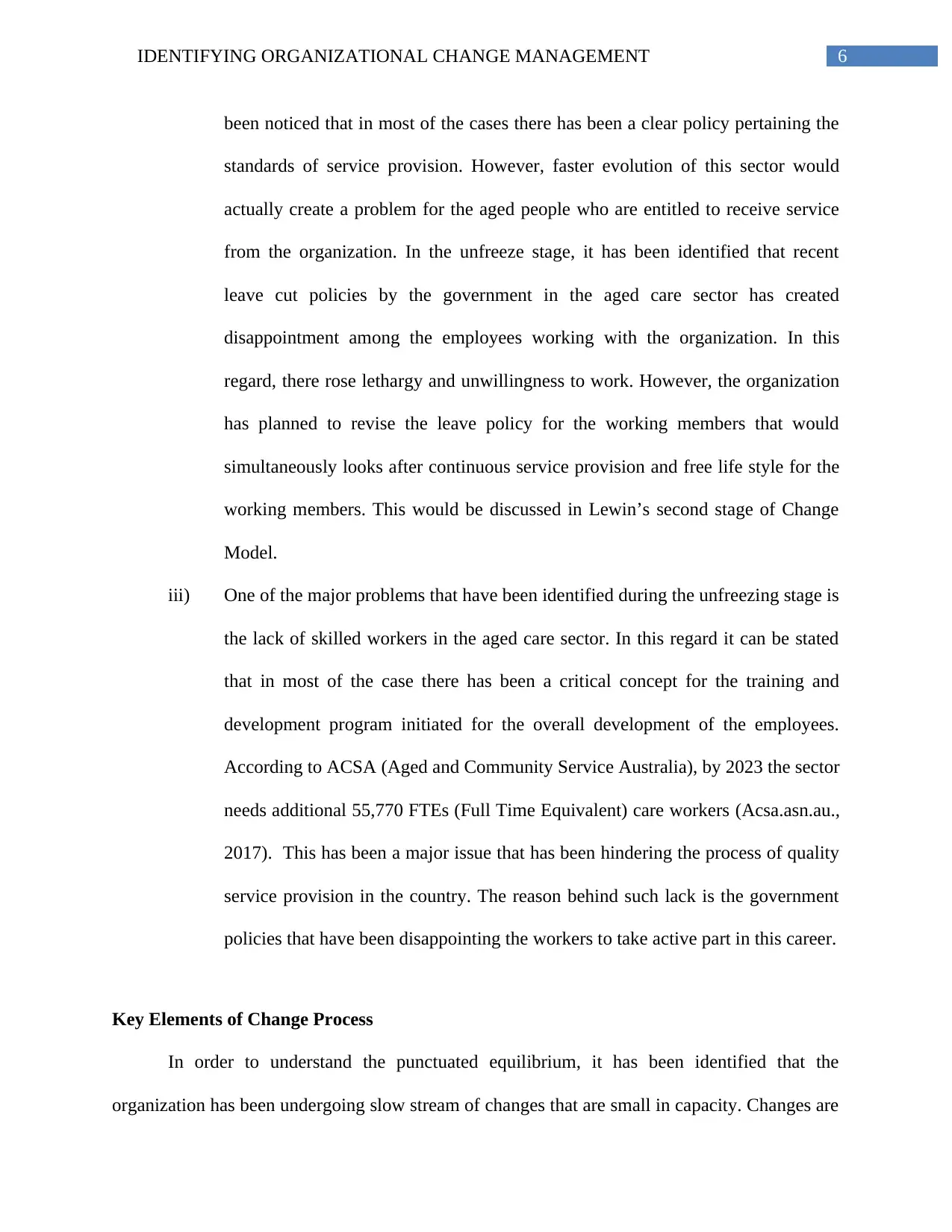
6IDENTIFYING ORGANIZATIONAL CHANGE MANAGEMENT
been noticed that in most of the cases there has been a clear policy pertaining the
standards of service provision. However, faster evolution of this sector would
actually create a problem for the aged people who are entitled to receive service
from the organization. In the unfreeze stage, it has been identified that recent
leave cut policies by the government in the aged care sector has created
disappointment among the employees working with the organization. In this
regard, there rose lethargy and unwillingness to work. However, the organization
has planned to revise the leave policy for the working members that would
simultaneously looks after continuous service provision and free life style for the
working members. This would be discussed in Lewin’s second stage of Change
Model.
iii) One of the major problems that have been identified during the unfreezing stage is
the lack of skilled workers in the aged care sector. In this regard it can be stated
that in most of the case there has been a critical concept for the training and
development program initiated for the overall development of the employees.
According to ACSA (Aged and Community Service Australia), by 2023 the sector
needs additional 55,770 FTEs (Full Time Equivalent) care workers (Acsa.asn.au.,
2017). This has been a major issue that has been hindering the process of quality
service provision in the country. The reason behind such lack is the government
policies that have been disappointing the workers to take active part in this career.
Key Elements of Change Process
In order to understand the punctuated equilibrium, it has been identified that the
organization has been undergoing slow stream of changes that are small in capacity. Changes are
been noticed that in most of the cases there has been a clear policy pertaining the
standards of service provision. However, faster evolution of this sector would
actually create a problem for the aged people who are entitled to receive service
from the organization. In the unfreeze stage, it has been identified that recent
leave cut policies by the government in the aged care sector has created
disappointment among the employees working with the organization. In this
regard, there rose lethargy and unwillingness to work. However, the organization
has planned to revise the leave policy for the working members that would
simultaneously looks after continuous service provision and free life style for the
working members. This would be discussed in Lewin’s second stage of Change
Model.
iii) One of the major problems that have been identified during the unfreezing stage is
the lack of skilled workers in the aged care sector. In this regard it can be stated
that in most of the case there has been a critical concept for the training and
development program initiated for the overall development of the employees.
According to ACSA (Aged and Community Service Australia), by 2023 the sector
needs additional 55,770 FTEs (Full Time Equivalent) care workers (Acsa.asn.au.,
2017). This has been a major issue that has been hindering the process of quality
service provision in the country. The reason behind such lack is the government
policies that have been disappointing the workers to take active part in this career.
Key Elements of Change Process
In order to understand the punctuated equilibrium, it has been identified that the
organization has been undergoing slow stream of changes that are small in capacity. Changes are
⊘ This is a preview!⊘
Do you want full access?
Subscribe today to unlock all pages.

Trusted by 1+ million students worldwide
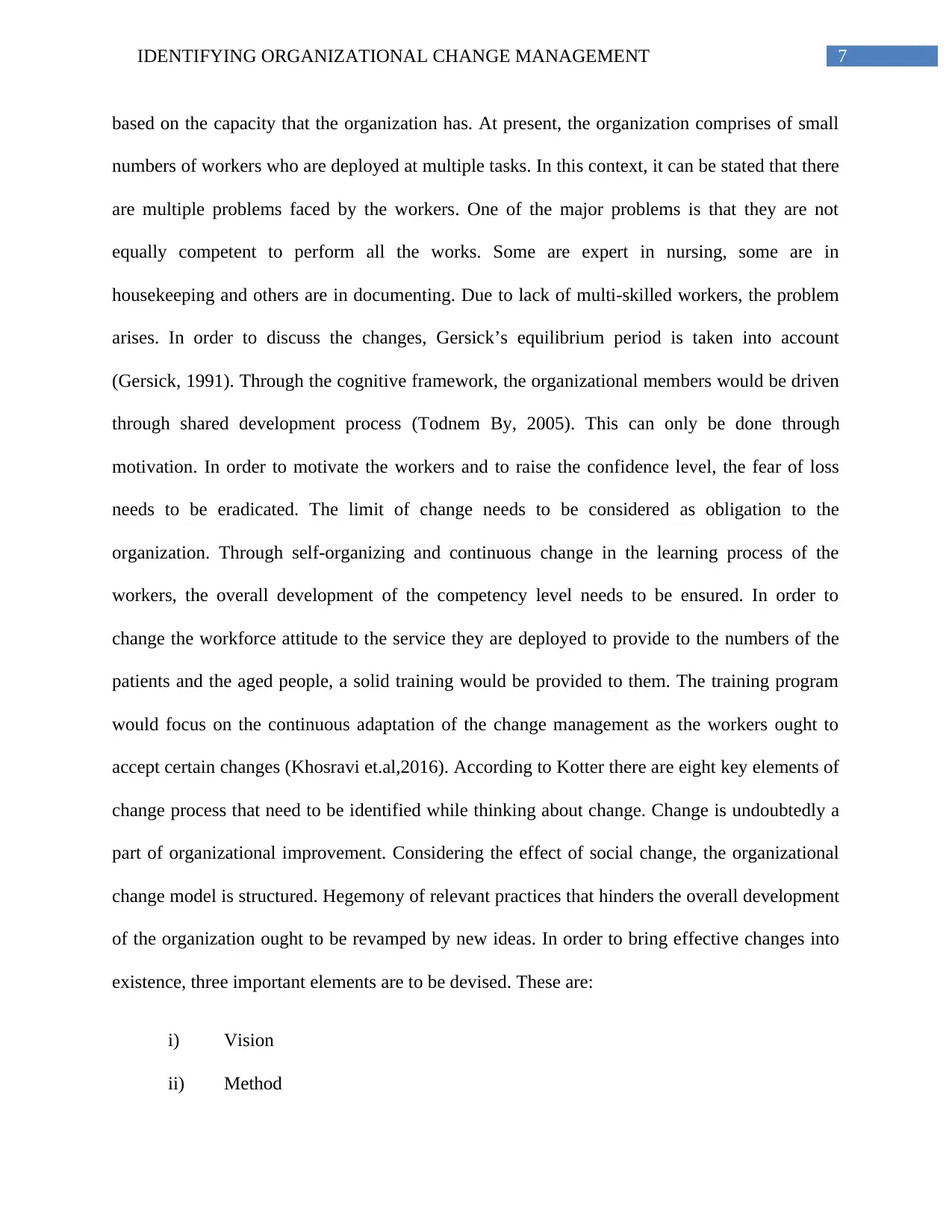
7IDENTIFYING ORGANIZATIONAL CHANGE MANAGEMENT
based on the capacity that the organization has. At present, the organization comprises of small
numbers of workers who are deployed at multiple tasks. In this context, it can be stated that there
are multiple problems faced by the workers. One of the major problems is that they are not
equally competent to perform all the works. Some are expert in nursing, some are in
housekeeping and others are in documenting. Due to lack of multi-skilled workers, the problem
arises. In order to discuss the changes, Gersick’s equilibrium period is taken into account
(Gersick, 1991). Through the cognitive framework, the organizational members would be driven
through shared development process (Todnem By, 2005). This can only be done through
motivation. In order to motivate the workers and to raise the confidence level, the fear of loss
needs to be eradicated. The limit of change needs to be considered as obligation to the
organization. Through self-organizing and continuous change in the learning process of the
workers, the overall development of the competency level needs to be ensured. In order to
change the workforce attitude to the service they are deployed to provide to the numbers of the
patients and the aged people, a solid training would be provided to them. The training program
would focus on the continuous adaptation of the change management as the workers ought to
accept certain changes (Khosravi et.al,2016). According to Kotter there are eight key elements of
change process that need to be identified while thinking about change. Change is undoubtedly a
part of organizational improvement. Considering the effect of social change, the organizational
change model is structured. Hegemony of relevant practices that hinders the overall development
of the organization ought to be revamped by new ideas. In order to bring effective changes into
existence, three important elements are to be devised. These are:
i) Vision
ii) Method
based on the capacity that the organization has. At present, the organization comprises of small
numbers of workers who are deployed at multiple tasks. In this context, it can be stated that there
are multiple problems faced by the workers. One of the major problems is that they are not
equally competent to perform all the works. Some are expert in nursing, some are in
housekeeping and others are in documenting. Due to lack of multi-skilled workers, the problem
arises. In order to discuss the changes, Gersick’s equilibrium period is taken into account
(Gersick, 1991). Through the cognitive framework, the organizational members would be driven
through shared development process (Todnem By, 2005). This can only be done through
motivation. In order to motivate the workers and to raise the confidence level, the fear of loss
needs to be eradicated. The limit of change needs to be considered as obligation to the
organization. Through self-organizing and continuous change in the learning process of the
workers, the overall development of the competency level needs to be ensured. In order to
change the workforce attitude to the service they are deployed to provide to the numbers of the
patients and the aged people, a solid training would be provided to them. The training program
would focus on the continuous adaptation of the change management as the workers ought to
accept certain changes (Khosravi et.al,2016). According to Kotter there are eight key elements of
change process that need to be identified while thinking about change. Change is undoubtedly a
part of organizational improvement. Considering the effect of social change, the organizational
change model is structured. Hegemony of relevant practices that hinders the overall development
of the organization ought to be revamped by new ideas. In order to bring effective changes into
existence, three important elements are to be devised. These are:
i) Vision
ii) Method
Paraphrase This Document
Need a fresh take? Get an instant paraphrase of this document with our AI Paraphraser
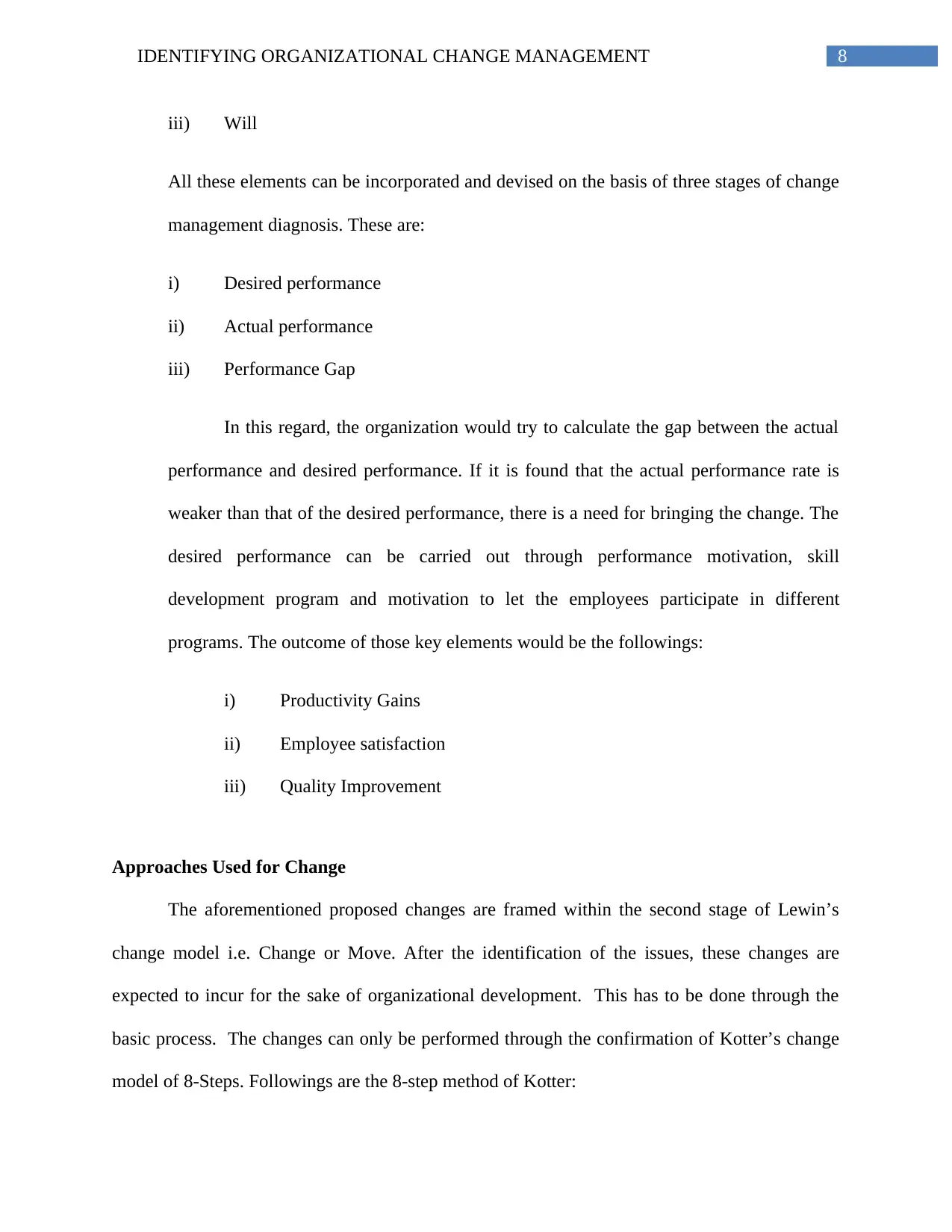
8IDENTIFYING ORGANIZATIONAL CHANGE MANAGEMENT
iii) Will
All these elements can be incorporated and devised on the basis of three stages of change
management diagnosis. These are:
i) Desired performance
ii) Actual performance
iii) Performance Gap
In this regard, the organization would try to calculate the gap between the actual
performance and desired performance. If it is found that the actual performance rate is
weaker than that of the desired performance, there is a need for bringing the change. The
desired performance can be carried out through performance motivation, skill
development program and motivation to let the employees participate in different
programs. The outcome of those key elements would be the followings:
i) Productivity Gains
ii) Employee satisfaction
iii) Quality Improvement
Approaches Used for Change
The aforementioned proposed changes are framed within the second stage of Lewin’s
change model i.e. Change or Move. After the identification of the issues, these changes are
expected to incur for the sake of organizational development. This has to be done through the
basic process. The changes can only be performed through the confirmation of Kotter’s change
model of 8-Steps. Followings are the 8-step method of Kotter:
iii) Will
All these elements can be incorporated and devised on the basis of three stages of change
management diagnosis. These are:
i) Desired performance
ii) Actual performance
iii) Performance Gap
In this regard, the organization would try to calculate the gap between the actual
performance and desired performance. If it is found that the actual performance rate is
weaker than that of the desired performance, there is a need for bringing the change. The
desired performance can be carried out through performance motivation, skill
development program and motivation to let the employees participate in different
programs. The outcome of those key elements would be the followings:
i) Productivity Gains
ii) Employee satisfaction
iii) Quality Improvement
Approaches Used for Change
The aforementioned proposed changes are framed within the second stage of Lewin’s
change model i.e. Change or Move. After the identification of the issues, these changes are
expected to incur for the sake of organizational development. This has to be done through the
basic process. The changes can only be performed through the confirmation of Kotter’s change
model of 8-Steps. Followings are the 8-step method of Kotter:
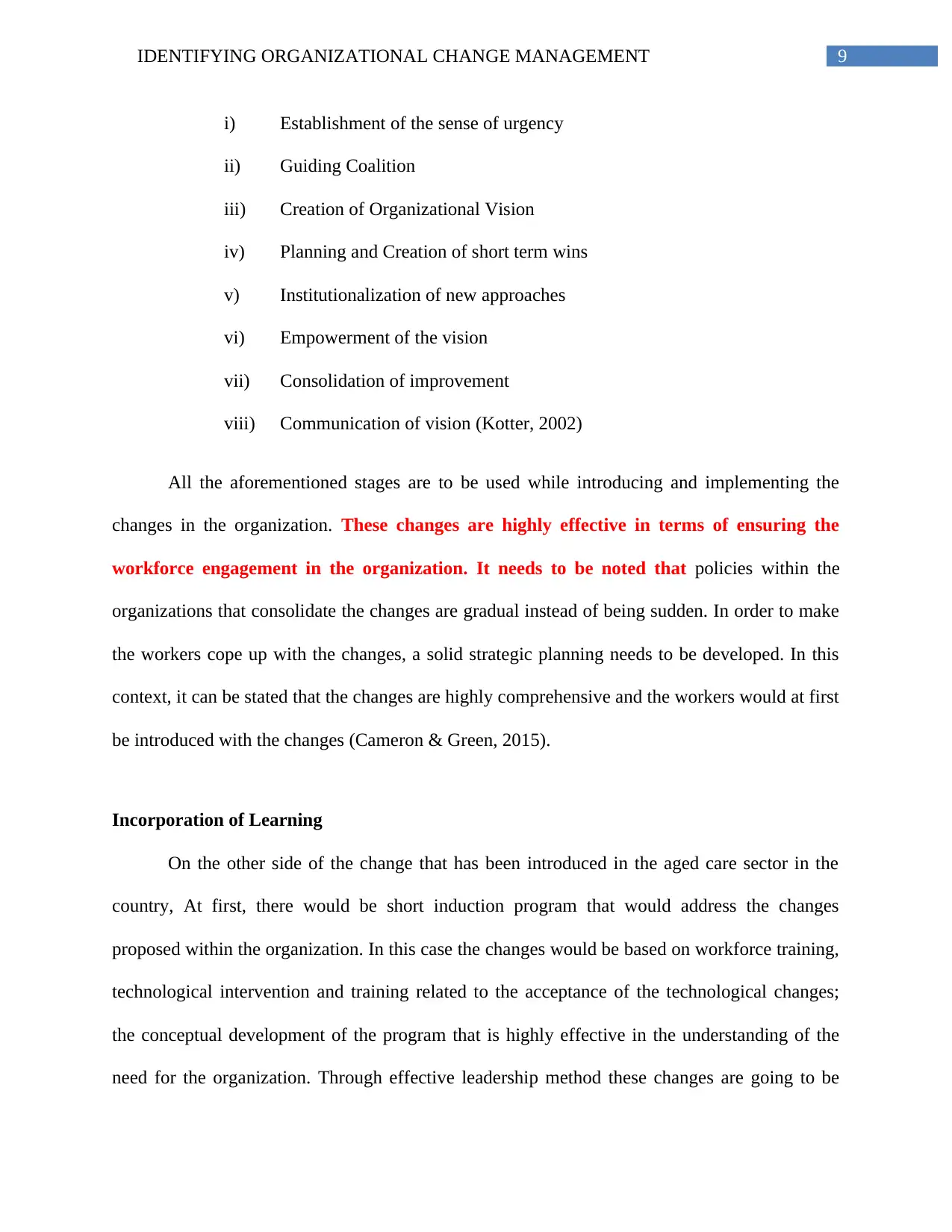
9IDENTIFYING ORGANIZATIONAL CHANGE MANAGEMENT
i) Establishment of the sense of urgency
ii) Guiding Coalition
iii) Creation of Organizational Vision
iv) Planning and Creation of short term wins
v) Institutionalization of new approaches
vi) Empowerment of the vision
vii) Consolidation of improvement
viii) Communication of vision (Kotter, 2002)
All the aforementioned stages are to be used while introducing and implementing the
changes in the organization. These changes are highly effective in terms of ensuring the
workforce engagement in the organization. It needs to be noted that policies within the
organizations that consolidate the changes are gradual instead of being sudden. In order to make
the workers cope up with the changes, a solid strategic planning needs to be developed. In this
context, it can be stated that the changes are highly comprehensive and the workers would at first
be introduced with the changes (Cameron & Green, 2015).
Incorporation of Learning
On the other side of the change that has been introduced in the aged care sector in the
country, At first, there would be short induction program that would address the changes
proposed within the organization. In this case the changes would be based on workforce training,
technological intervention and training related to the acceptance of the technological changes;
the conceptual development of the program that is highly effective in the understanding of the
need for the organization. Through effective leadership method these changes are going to be
i) Establishment of the sense of urgency
ii) Guiding Coalition
iii) Creation of Organizational Vision
iv) Planning and Creation of short term wins
v) Institutionalization of new approaches
vi) Empowerment of the vision
vii) Consolidation of improvement
viii) Communication of vision (Kotter, 2002)
All the aforementioned stages are to be used while introducing and implementing the
changes in the organization. These changes are highly effective in terms of ensuring the
workforce engagement in the organization. It needs to be noted that policies within the
organizations that consolidate the changes are gradual instead of being sudden. In order to make
the workers cope up with the changes, a solid strategic planning needs to be developed. In this
context, it can be stated that the changes are highly comprehensive and the workers would at first
be introduced with the changes (Cameron & Green, 2015).
Incorporation of Learning
On the other side of the change that has been introduced in the aged care sector in the
country, At first, there would be short induction program that would address the changes
proposed within the organization. In this case the changes would be based on workforce training,
technological intervention and training related to the acceptance of the technological changes;
the conceptual development of the program that is highly effective in the understanding of the
need for the organization. Through effective leadership method these changes are going to be
⊘ This is a preview!⊘
Do you want full access?
Subscribe today to unlock all pages.

Trusted by 1+ million students worldwide
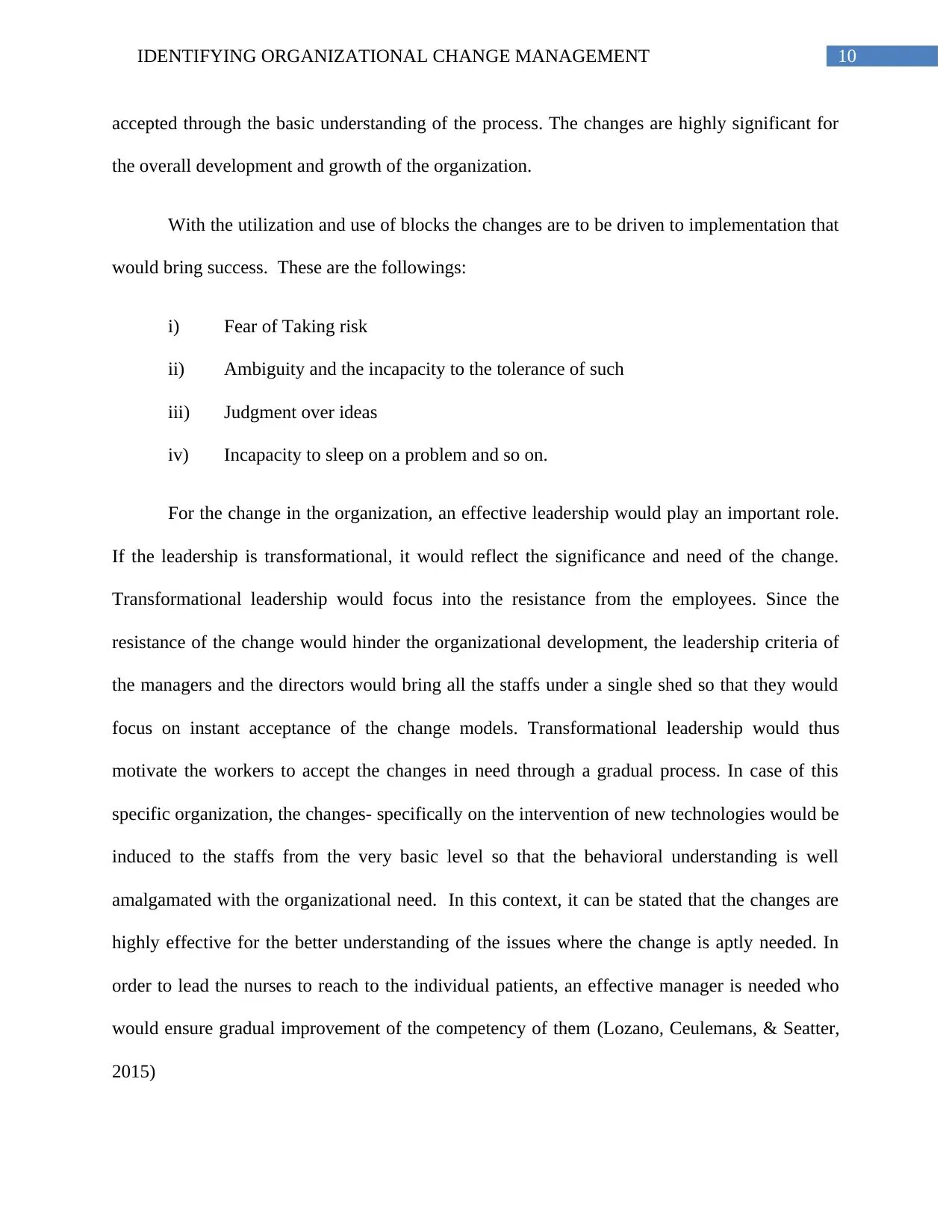
10IDENTIFYING ORGANIZATIONAL CHANGE MANAGEMENT
accepted through the basic understanding of the process. The changes are highly significant for
the overall development and growth of the organization.
With the utilization and use of blocks the changes are to be driven to implementation that
would bring success. These are the followings:
i) Fear of Taking risk
ii) Ambiguity and the incapacity to the tolerance of such
iii) Judgment over ideas
iv) Incapacity to sleep on a problem and so on.
For the change in the organization, an effective leadership would play an important role.
If the leadership is transformational, it would reflect the significance and need of the change.
Transformational leadership would focus into the resistance from the employees. Since the
resistance of the change would hinder the organizational development, the leadership criteria of
the managers and the directors would bring all the staffs under a single shed so that they would
focus on instant acceptance of the change models. Transformational leadership would thus
motivate the workers to accept the changes in need through a gradual process. In case of this
specific organization, the changes- specifically on the intervention of new technologies would be
induced to the staffs from the very basic level so that the behavioral understanding is well
amalgamated with the organizational need. In this context, it can be stated that the changes are
highly effective for the better understanding of the issues where the change is aptly needed. In
order to lead the nurses to reach to the individual patients, an effective manager is needed who
would ensure gradual improvement of the competency of them (Lozano, Ceulemans, & Seatter,
2015)
accepted through the basic understanding of the process. The changes are highly significant for
the overall development and growth of the organization.
With the utilization and use of blocks the changes are to be driven to implementation that
would bring success. These are the followings:
i) Fear of Taking risk
ii) Ambiguity and the incapacity to the tolerance of such
iii) Judgment over ideas
iv) Incapacity to sleep on a problem and so on.
For the change in the organization, an effective leadership would play an important role.
If the leadership is transformational, it would reflect the significance and need of the change.
Transformational leadership would focus into the resistance from the employees. Since the
resistance of the change would hinder the organizational development, the leadership criteria of
the managers and the directors would bring all the staffs under a single shed so that they would
focus on instant acceptance of the change models. Transformational leadership would thus
motivate the workers to accept the changes in need through a gradual process. In case of this
specific organization, the changes- specifically on the intervention of new technologies would be
induced to the staffs from the very basic level so that the behavioral understanding is well
amalgamated with the organizational need. In this context, it can be stated that the changes are
highly effective for the better understanding of the issues where the change is aptly needed. In
order to lead the nurses to reach to the individual patients, an effective manager is needed who
would ensure gradual improvement of the competency of them (Lozano, Ceulemans, & Seatter,
2015)
Paraphrase This Document
Need a fresh take? Get an instant paraphrase of this document with our AI Paraphraser
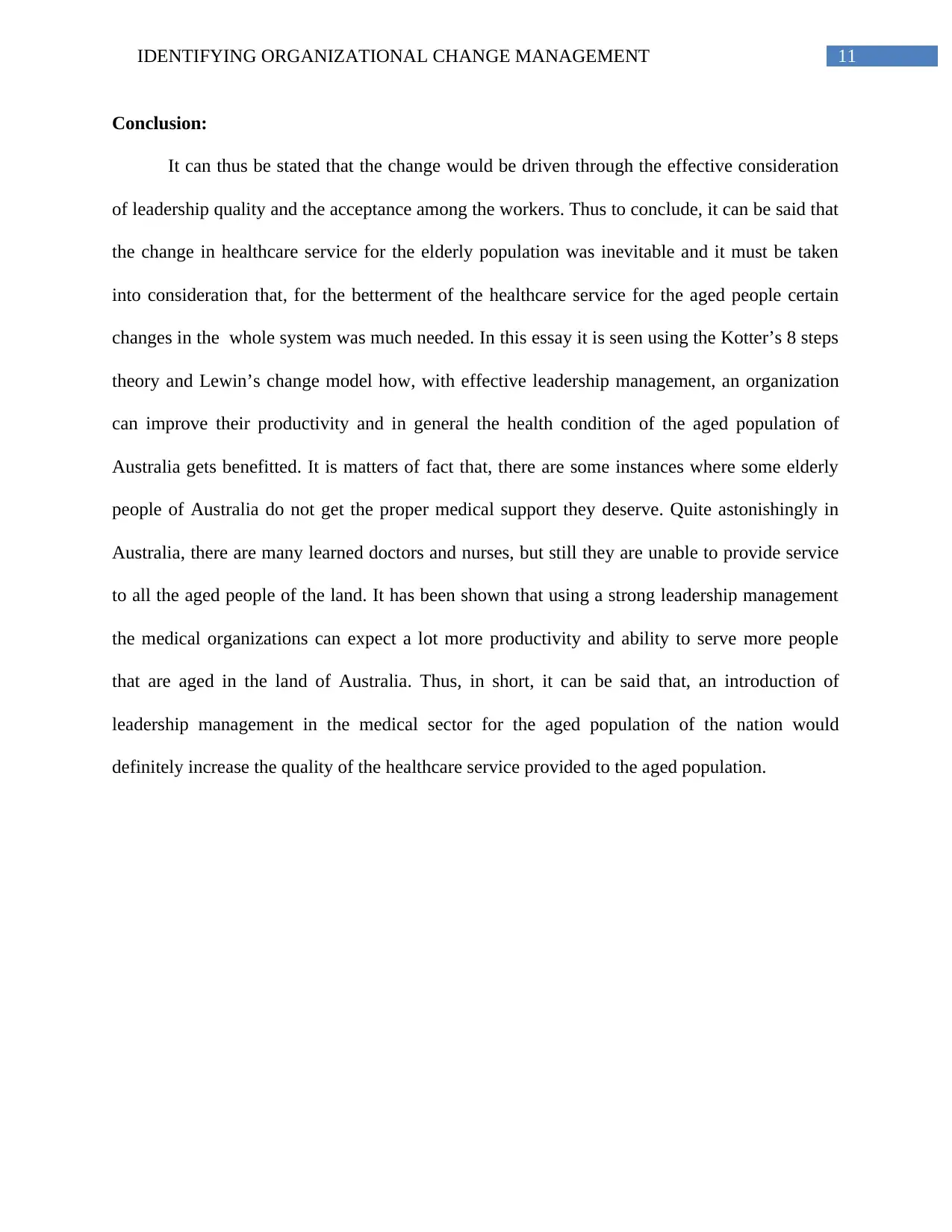
11IDENTIFYING ORGANIZATIONAL CHANGE MANAGEMENT
Conclusion:
It can thus be stated that the change would be driven through the effective consideration
of leadership quality and the acceptance among the workers. Thus to conclude, it can be said that
the change in healthcare service for the elderly population was inevitable and it must be taken
into consideration that, for the betterment of the healthcare service for the aged people certain
changes in the whole system was much needed. In this essay it is seen using the Kotter’s 8 steps
theory and Lewin’s change model how, with effective leadership management, an organization
can improve their productivity and in general the health condition of the aged population of
Australia gets benefitted. It is matters of fact that, there are some instances where some elderly
people of Australia do not get the proper medical support they deserve. Quite astonishingly in
Australia, there are many learned doctors and nurses, but still they are unable to provide service
to all the aged people of the land. It has been shown that using a strong leadership management
the medical organizations can expect a lot more productivity and ability to serve more people
that are aged in the land of Australia. Thus, in short, it can be said that, an introduction of
leadership management in the medical sector for the aged population of the nation would
definitely increase the quality of the healthcare service provided to the aged population.
Conclusion:
It can thus be stated that the change would be driven through the effective consideration
of leadership quality and the acceptance among the workers. Thus to conclude, it can be said that
the change in healthcare service for the elderly population was inevitable and it must be taken
into consideration that, for the betterment of the healthcare service for the aged people certain
changes in the whole system was much needed. In this essay it is seen using the Kotter’s 8 steps
theory and Lewin’s change model how, with effective leadership management, an organization
can improve their productivity and in general the health condition of the aged population of
Australia gets benefitted. It is matters of fact that, there are some instances where some elderly
people of Australia do not get the proper medical support they deserve. Quite astonishingly in
Australia, there are many learned doctors and nurses, but still they are unable to provide service
to all the aged people of the land. It has been shown that using a strong leadership management
the medical organizations can expect a lot more productivity and ability to serve more people
that are aged in the land of Australia. Thus, in short, it can be said that, an introduction of
leadership management in the medical sector for the aged population of the nation would
definitely increase the quality of the healthcare service provided to the aged population.
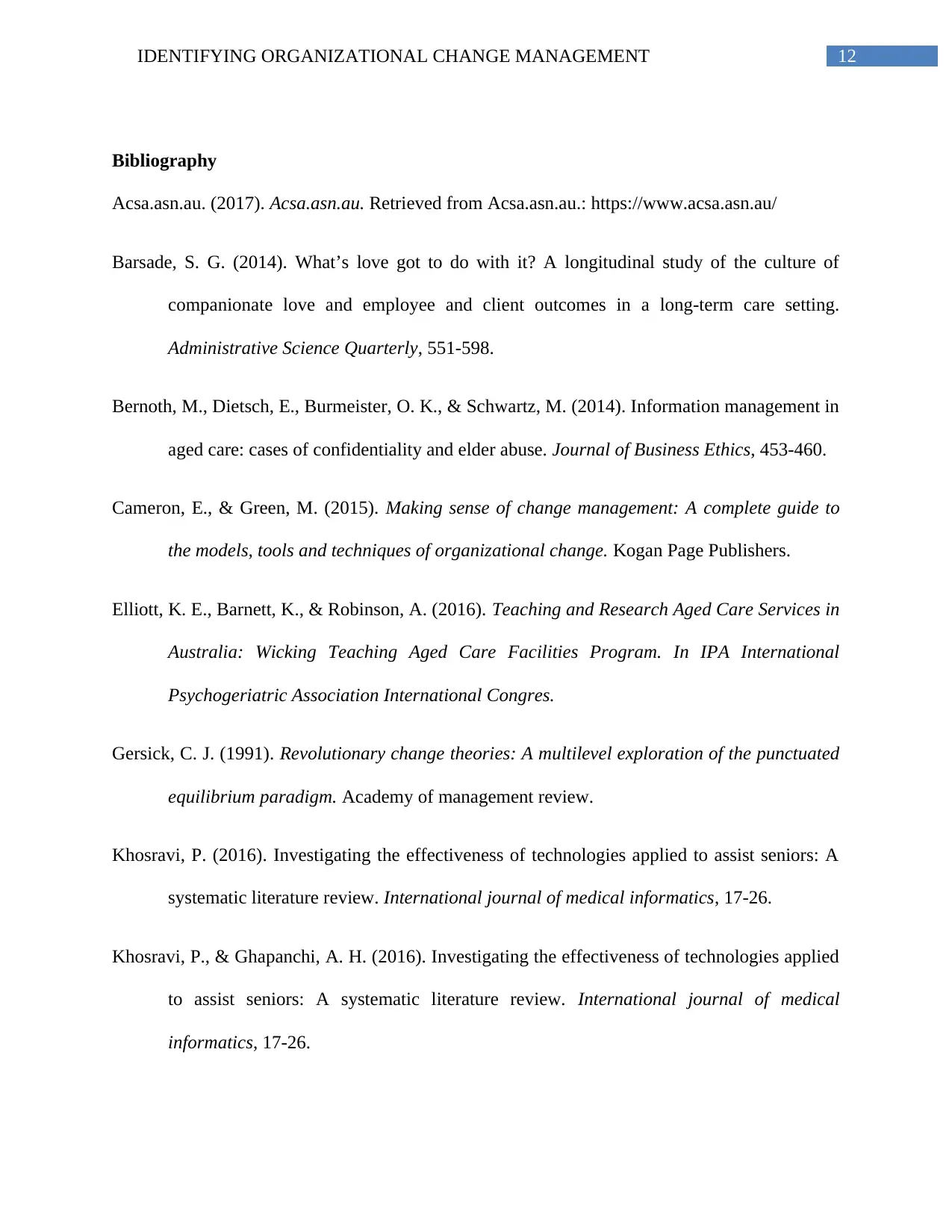
12IDENTIFYING ORGANIZATIONAL CHANGE MANAGEMENT
Bibliography
Acsa.asn.au. (2017). Acsa.asn.au. Retrieved from Acsa.asn.au.: https://www.acsa.asn.au/
Barsade, S. G. (2014). What’s love got to do with it? A longitudinal study of the culture of
companionate love and employee and client outcomes in a long-term care setting.
Administrative Science Quarterly, 551-598.
Bernoth, M., Dietsch, E., Burmeister, O. K., & Schwartz, M. (2014). Information management in
aged care: cases of confidentiality and elder abuse. Journal of Business Ethics, 453-460.
Cameron, E., & Green, M. (2015). Making sense of change management: A complete guide to
the models, tools and techniques of organizational change. Kogan Page Publishers.
Elliott, K. E., Barnett, K., & Robinson, A. (2016). Teaching and Research Aged Care Services in
Australia: Wicking Teaching Aged Care Facilities Program. In IPA International
Psychogeriatric Association International Congres.
Gersick, C. J. (1991). Revolutionary change theories: A multilevel exploration of the punctuated
equilibrium paradigm. Academy of management review.
Khosravi, P. (2016). Investigating the effectiveness of technologies applied to assist seniors: A
systematic literature review. International journal of medical informatics, 17-26.
Khosravi, P., & Ghapanchi, A. H. (2016). Investigating the effectiveness of technologies applied
to assist seniors: A systematic literature review. International journal of medical
informatics, 17-26.
Bibliography
Acsa.asn.au. (2017). Acsa.asn.au. Retrieved from Acsa.asn.au.: https://www.acsa.asn.au/
Barsade, S. G. (2014). What’s love got to do with it? A longitudinal study of the culture of
companionate love and employee and client outcomes in a long-term care setting.
Administrative Science Quarterly, 551-598.
Bernoth, M., Dietsch, E., Burmeister, O. K., & Schwartz, M. (2014). Information management in
aged care: cases of confidentiality and elder abuse. Journal of Business Ethics, 453-460.
Cameron, E., & Green, M. (2015). Making sense of change management: A complete guide to
the models, tools and techniques of organizational change. Kogan Page Publishers.
Elliott, K. E., Barnett, K., & Robinson, A. (2016). Teaching and Research Aged Care Services in
Australia: Wicking Teaching Aged Care Facilities Program. In IPA International
Psychogeriatric Association International Congres.
Gersick, C. J. (1991). Revolutionary change theories: A multilevel exploration of the punctuated
equilibrium paradigm. Academy of management review.
Khosravi, P. (2016). Investigating the effectiveness of technologies applied to assist seniors: A
systematic literature review. International journal of medical informatics, 17-26.
Khosravi, P., & Ghapanchi, A. H. (2016). Investigating the effectiveness of technologies applied
to assist seniors: A systematic literature review. International journal of medical
informatics, 17-26.
⊘ This is a preview!⊘
Do you want full access?
Subscribe today to unlock all pages.

Trusted by 1+ million students worldwide
1 out of 13